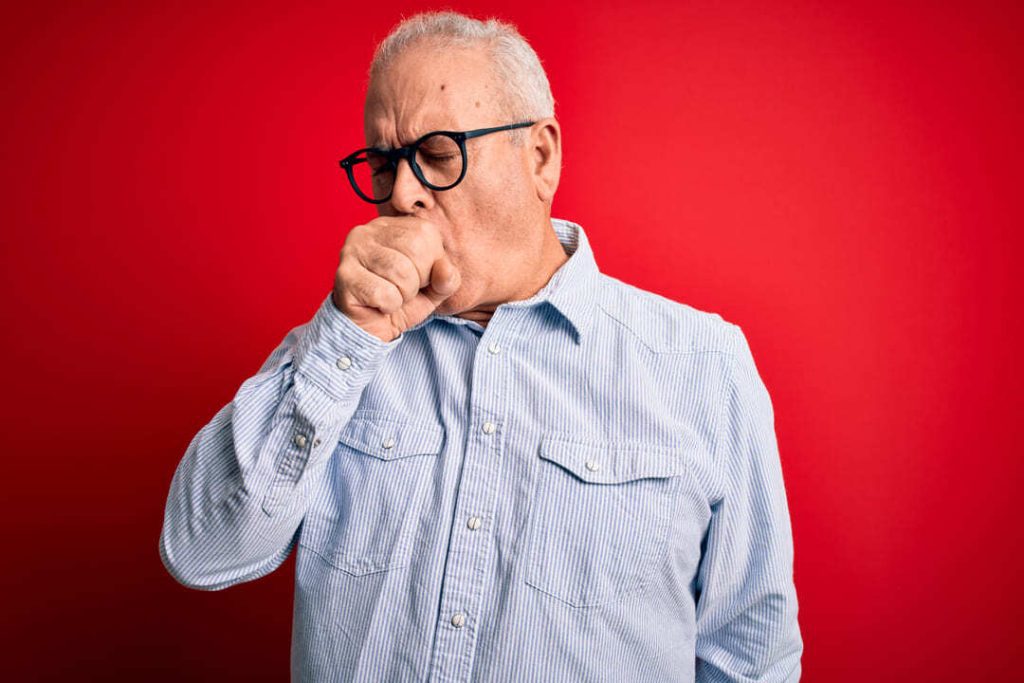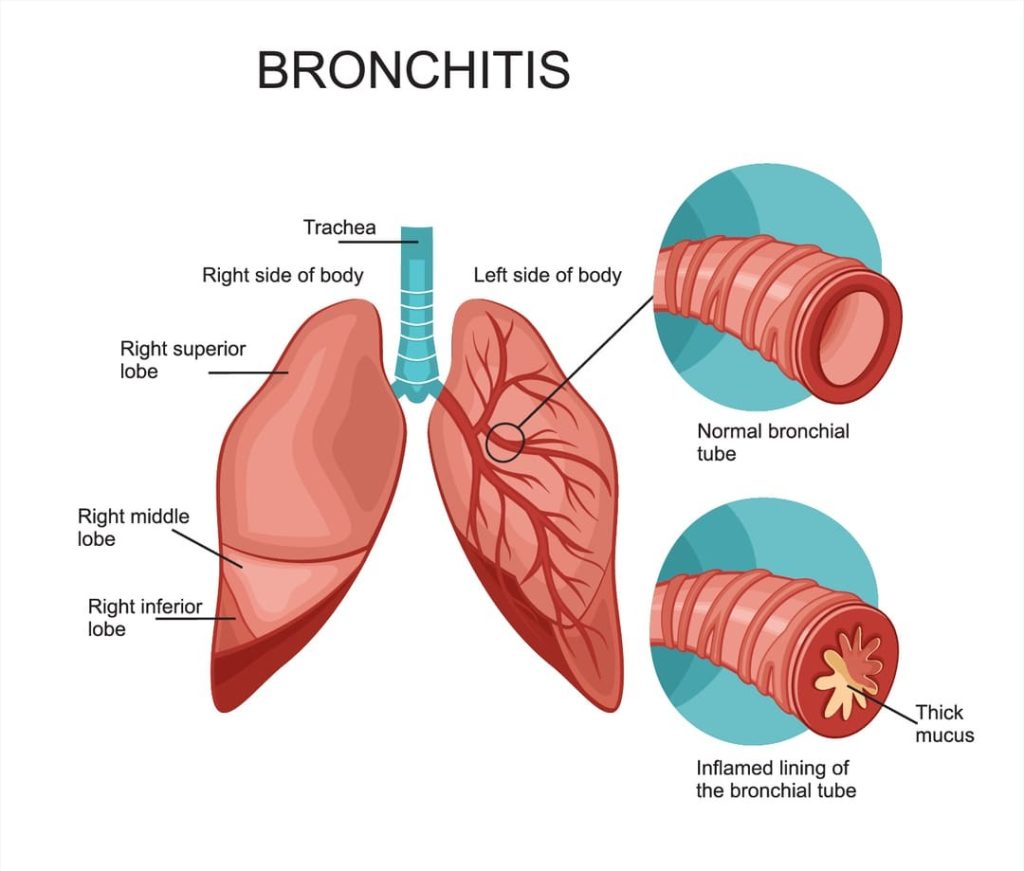Looking for Expert-Level VA Claim Answers?📱Call Us Now! 737-295-2226
In this guide, we break down chronic bronchitis VA ratings. A VA rating for bronchitis can be awarded at 10%, 30%, 60%, or 100%, for veterans who meet specific criteria.
Healthy adults don’t usually think about breathing. We take about 20,000 breaths each day. Still, it’s a constant struggle for veterans with bronchitis that can severely impact their quality of life. Our goal in this guide is to show you the evidence you need and the steps to take to file a successful claim to earn a bronchitis VA rating.
Thousands of veterans suffer from respiratory disabilities. In a study of veterans, the VA found that nearly 14% suffered from a respiratory condition, including bronchitis, asthma, or COPD.
Table of Contents

IMPORTANT UPDATE: Chronic bronchitis VA claims for many Gulf War and post-9/11 veterans are now covered under presumptive service connection for the PACT Act of 2022. Read on to learn more about how this new change may apply to you.
What is Bronchitis?
Bronchitis is an inflammation of the large airways that carry oxygen to the lungs.
If you have bronchitis, you may experience difficulty breathing. This is because bronchitis can cause the airways to swell and produce mucus. The mucus can make it difficult for air to flow through the lungs. As a result, you may feel short of breath or experience chest pain. Over time, your lungs deteriorate as they work harder to compensate.

There are two types of bronchitis: acute and chronic.
- Acute bronchitis is a short-term illness usually caused by a viral infection.
- Chronic bronchitis is a cough and mucus for most days that lasts for at least three months in a year.
VA rating for bronchitis is based on chronic bronchitis. Chronic bronchitis is a long-term illness usually caused by exposure to irritants, such as smoke, pollution, and other toxins.
Veteran Exposure to Burn Pits and Bronchitis
Veterans, in particular, are at a higher risk for bronchitis due to their exposure to burn pits and other toxins during service. The burn pits disposed of everything from chemicals, medical supplies, and asbestos to human waste.
Burn pit emissions often contain harmful chemicals that could cause bronchitis and other severe respiratory conditions. In some locations, these burn pits spanned over 10 acres of land, with smoke passing over the entire base during windy conditions. Many of these particles weren’t visible to the naked eye, so veterans may be surprised to develop these conditions years to decades later.
Chronic Bronchitis Symptoms
Many veterans don’t immediately develop bronchitis as a result of their exposure. Bronchitis may take years to develop.
The symptoms of bronchitis include:
- A cough that produces mucus
- Shortness of breath
- Wheezing
- Chest pain or tightness
- A sore throat
- Fever or chills
- Fatigue
While many different respiratory conditions can be confused with bronchitis (or include bronchitis, like COPD), bronchitis is often recognized by phlegm or mucus.
Veterans with chronic bronchitis may also be at a higher risk for heart disease. In addition, chronic bronchitis can lead to other respiratory illnesses, such as pneumonia. To prevent further complications, seek treatment if you’re suffering from bronchitis.
Chronic Bronchitis VA Ratings
Disease of the Trachea and Bronchi (Diagnostic Code 6600): A VA disability rating for bronchitis can be 10%, 30%, 60%, or 100%, based on the severity of your condition, including:
- How long it takes you to breath
- How much air you’re inhaling and exhaling
- How well you can exercise
How do you prove chronic bronchitis to the VA?
Your VA rating for chronic bronchitis is heavily based on breathing tests that measure several different components. The VA will want to monitor your progress over time since bronchitis can improve, so you can expect to take these several times.
Forced Expiratory Volume in 1 Second (or FEV-1)
FEV-1 is the maximum amount of air you can breathe out in 1 second compared to a healthy person your age. FEV-1 is shown as a percentage, as you’re being compared to a healthy person like you. A 10% COPD VA rating starts if you can only breathe out 80% of the air of a healthy person.
Forced Vital Capacity (FVC)
FVC is a test that measures how much air you can exhale after taking a full breath.
Diffusion Capacity of the Lung for Carbon Dioxide (DLCO)
This test measures your body’s ability to transfer oxygen into red blood cells.
The VA uses Diagnostic Code 6600 under the Schedule of Ratings to determine the severity of your bronchitis and award you a rating.
Remember that bronchitis can improve over time, so the VA probably won’t give you a permanent rating. You may have to return to the VA within 5-10 for a re-evaluation.
Below is a list of how the VA awards ratings based on your lung functioning with the tests we explained above. For each rating, only one criterion must be met for the VA to award that rating.
- 10% – requires one of the following:
- FEV-1 or FEV-1/FVC is 71% – 80% predicted
- DLCO (SB) is 71% – 80% predicted
- 30% – requires one of the following:
- FEV-1 or FEV-1/FVC is 56% – 70% predicted
- DLCO (SB) is 56% – 70% predicted
- 60% – requires one of the following:
- FEV-1 or FEV-1/FVC is 40% – 55% predicted
- DLCO (SB) is 40% – 55% predicted
- Maximum oxygen consumption is 15 to 20 ml/kg/min
- 100% – requires one of the following:
- FEV-1 or FEV-1/FVC is less than 40% predicted
- DLCO (SB) is less than 40% predicted
- Maximum oxygen consumption is less than 15 ml/kg/min
- Right heart failure
- Right ventricular hypertrophy
- Pulmonary hypertension
- Experienced an episode of acute respiratory failure
- Requires outpatient oxygen therapy
If you have more than one respiratory condition, the VA will only award you benefits for one of these disabilities. The VA will grant you a rating based on the disability with the highest percentage rating.
You can use our calculator to determine your VA compensation for bronchitis based on your rating above.
To start your claim for a bronchitis VA rating, gather your evidence and submit your intent to file.
There are a few ways to file a VA disability claim, using VA Form 21-526EZ:
- Online
- Mailing in forms
- In-person at your local regional VA office
How to File a VA Claim for Chronic Bronchitis
To get a VA disability rating for chronic bronchitis with direct service connection, you must prove three essential elements:
- You have a medical diagnosis of bronchitis.
- You experienced an active-duty service event or injury that caused your bronchitis or worsened it, or another service-connected disability caused or worsened your bronchitis.
- There is a link (or nexus) between your bronchitis and your military service.
Getting A Diagnosis
To diagnose chronic bronchitis, your doctor will probably do a physical exam and look at your medical history and symptoms. They may request a chest X-ray to rule out other lung problems. Other possibilities include:
- Blood tests
- Pulmonary function testing (often a spirometry test)
- Sputum exam (analysis of the cells in your mucus)
- Bronchoscopy (visual exam of your lungs with a camera)
Remember, bronchitis becomes chronic when it lasts for at least three months in a year. Showing this medical history is important when filing your claim.
You or your doctor can also complete the VA’s Respiratory Conditions Disability Benefits Questionnaire to improve the strength of your claim.
Bronchitis and Presumptive Service Connection
If you’re covered under presumptive service connection, the VA assumes your bronchitis is related to your service. You will still need a medical diagnosis and evidence of bronchitis. Still, you won’t need to establish a link between your bronchitis and service to be awarded a chronic bronchitis VA rating.
With the signing of the PACT Act in August 2022, Congress officially acknowledged many more sources that exposed veterans to toxins throughout their service. The list of conditions the VA must grant presumptive service connection to significantly expanded and now includes chronic bronchitis.
When you qualify for a presumptive service connection disability, your claim is MUCH easier to win. All you need to show is that you have chronic bronchitis and were deployed to one of the eligible areas.
If you were deployed to one of these areas after August 2, 1990, you’re eligible for VA disability for bronchitis on a presumptive basis. You must have performed active military, naval, air, or space service while assigned to a duty station, including the airspace above:
- Bahrain
- Iraq
- Kuwait
- Oman
- Qatar
- Saudi Arabia
- Somalia
- United Arab Emirates
Or if you served on or after September 11, 2001, you’re covered for service in all of the above countries plus:
- Afghanistan
- Djibouti
- Egypt
- Jordan
- Lebanon
- Syria
- Yemen
- Uzbekistan
- Or any other country determined relevant by the Secretary
Chronic bronchitis claims have been granted effective dates of October 1, 2023. If a veteran is terminally ill, homeless, in severe financial difficulty, aged 85 or older, or can demonstrate other acceptable causes, August 10, 2022, is the effective date for claims.
What Happens After You File for a Bronchitis VA Rating?
After you file for a bronchitis VA rating, your claim will be reviewed by a Veterans Service Representative (VSR), who will gather your military and medical records.
Your evidence will be reviewed, and during this time, the VA will likely request you to schedule a Compensation and Pension (C&P) exam. The C&P exam is an important part of the claims process as it will document the severity of your bronchitis and will be used by the VA to determine your rating.
After your evidence is reviewed, your entire claim will be reviewed, and a recommendation on your bronchitis claim will be made. Filing a fully developed claim will help speed up this process.

Getting a bronchitis VA rating can be complicated, but we know exactly what evidence the VA is looking for to grant your claim. If you need help filing a bronchitis VA claim or disagree with the VA’s decision on your claim, VA Claims Insider is here to help. Our team of expert Veteran Coaches has helped thousands of veterans like you get the benefits they deserve.
Want Expert-Level Support for Your VA Disability Claim? WE GOT YOUR SIX!
How does VA Claims Insider help veterans?
We make the confusing and frustrating VA claim process EASY through our 8-step proprietary system and one-on-one coaching; we’re the VA Claim EXPERTS you can trust, and YOU are never alone in this fight against the VA!
You’ll also receive VA disability expert Brian Reese’s SEM Method Blueprint—a proven formula that has helped over 25,000 veterans win their VA disability claims faster:
Strategy + Education + Medical Evidence = VA Rating and Compensation You Deserve FASTER!
Start today and unlock an exceptional level of service you deserve for serving our country:
- You’ll hear from a VA Claim Expert over email within 15 minutes of signing up today.
- You’ll hear from your Veteran Coach team within 24 hours of all inquiries during normal business days/hours.
- Our terms are simple: IF WE DON’T WIN, YOU DON’T PAY. You have nothing to lose and everything to gain!
Click the red button below to start the process of winning your VA claim right now:
About VA Claims Insider

- VA Claims Insider is the #1 most trusted name in VA disability claims.
- Work directly with a VA claims coach who can educate you to VA claim victory.
- 25,000+ disabled veterans served in our membership programs since 2016.
- 30% average rating increase for veterans who complete our #1 rated Elite program.
- 4.7/5.0 average rating out of 5,500+ total reviews; over 4,500 5-star reviews.




